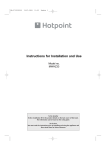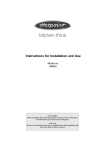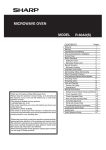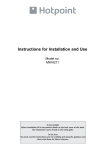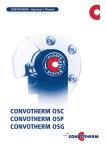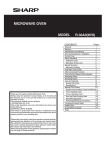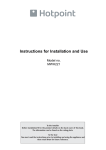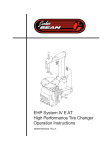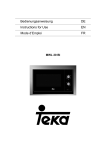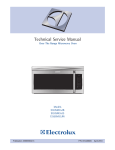Download DeLonghi MW 600 Technical data
Transcript
MW865 inc. •GB 23-04-2002 16:16 Pagina 1 MICROWAVE FAN OVEN WITH ELECTRONIC CONTROLS MW865 inc. •GB 23-04-2002 16:16 Pagina 2 Data and instruction for Performance Tests according to IEC 705 and further Amendment Document 59H/69/CD. The International Electrotechnical Commission SC 59H, has developed a Standard for comparative testing of heating performances of microwave ovens. The Draft of the new Edition of this Standard has been circulated with Document 59H/69/CD, which also describes the tests marked, in this table, with (*). We recommend the following for this oven: Test Nr. on standard Item Duration Function Power Level Oven temp. Weight Standing time Note A Egg custard 16 min. only mw 5 - 750 gr 5 min The upper surface shall be evaluated after the standing time. The inner custard evaluation shall be conducted after two hours. B Sponge cake 6 min. only mw 5 - 475 gr 5 min Use the borosilicate glass container stated in the Standard (max. dia. 210 mm) or a Pyrex® glass container dia. 210 mm, height 50 mm and wall thick 6 mm. Put the container on the low wire rack placed on the turntable. C Meat loaf 20 min. only mw 4 - 900 gr 5 min Cover the container with cling film and pierce the film. Use the rectangular borosilicate glass container stated in the Standard or the Arcopal® Cat. nr. Z1/B8 (01)10460-1. Defrosting Defrosting minced meat 11 min. only mw - 500 gr 15 min Place the frozen load directly on the turntable (I ). Turn upsidedown the load after half of the defrosting time. D (*) Potato gratin 30 min. combi mw + fan (simult.) 5 min Use the borosilicate glass container stated in the Standard (max. dia. 210 mm) or a Pyrex® glass container dia. 210 mm, height 50 mm and wall thick 6 mm. Put the container on the lower wire rack (F) placed on the turntable.Do not preheat the oven. 5 min Use the borosilicate glass container stated in the Standard (max dia. 210 mm) or a Pyrex® glass container dia. 210 mm, height 50 mm and wall thick 6 mm. The oven shall be preheated (in FAN ONLY function) with the lower rack (F) placed on the turntable. Once preheated, place the container on the lower rack (F). 5 min The following instruction shall be strictky observed for this type of load: put the chicken in a pyrex® glass container dia 210 mm, height 50 mm and wall thickness of 6 mm. Put the container on the lower wire rack (F) placed on the turntable. E (*) F (*) Sponge cake Poultry 30 min. combi mw + fan (simult.) 50 min. combi mw + fan (simult.) 4 2 4 170°C 160°C 190°C 1100 gr 710 gr 1200 gr MW865 inc. •GB 23-04-2002 16:16 Pagina 3 1 2 3 5 4 7 9 10 6 15 12 13 8 11 14 DESCRIPTION OF THE CONTROL PANEL 1. Time and mode display 7 - 8 - 9 - 10 - 11 2. Oven temperature display 3. Function Key: mode selection “AUTO” keys: pre programmed rapid selection 12. “STOP” key: interruption of cooking and 4. “°C” Temperature key: oven temperature selection 5. Power level key: microwave power level cancellation of settings 13. “START” key: start of cooking and rapid selection 6. Clock key: setting the clock reheating 14. Time Adjust knob: setting of time and cooking duration 15. Turntable stop key MW865 inc. •GB 23-04-2002 16:16 Pagina 4 BUILDING-IN Inside the oven there is a plastic bag with fixing material. Take this bag out of the oven. 1. Remove the two screws ‘X’ from the fastening bar under the microwave oven. 2. Fasten metal strip ‘A’ using the two screws ‘X’ that have just been removed. 55 0m in. 50 min . 8 0+ 0 450+2 0 ventilation 56 A 30 30 29 5m = = 850 min in. 18 X 458 X 5 59 The appliance needs sufficient ventilation. Make an opening in the plinth at least 280 cm2 large for this purpose. 4 MW865 inc. •GB 23-04-2002 16:16 Pagina 5 3. Fit the fastening bar ‘B’ at the correct position in the recess. Make sure that there is the same amount of free space at each side of the fastening bar. Fasten the bar with the screws ‘H’. H B B H = = B H Fix the fastening bar such that the two lips stick out over the edge of the bottom of the recess and rest against it at the front. 5 MW865 inc. •GB 23-04-2002 16:16 Pagina 6 4. Open the lid of the smoke discharge ‘C’ fully. 5. Slide the appliance into the recess. Slide the front of the appliance over the fastening bar ‘B’. Keep sliding it until the front of the oven ‘G’ is resting against the cupboard and the holes ‘D’ under the oven are aligned with the holes ‘E’ in the fastening bar ‘B’. 6. Fasten the appliance to the fastening bar ‘B’ using the screws ‘F’. G B C E F B D G D ELECTRICAL CONNECTION - IMPORTANT: If the appliance is provided with supply cord AND plug, the appliance shall be positioned so that the plug is always accessible. If the appliance is provided with a supply cord WITHOUT the plug, the appliance must be connected to a fixed main wiring incorporating a disconnection switch with contact separation of at least 3 mm in all poles and provided with permanent connection to earth. 6 MW865 inc. •GB 23-04-2002 16:16 Pagina 7 C A B D E F G H I L DESCRIPTION A B C D E F Grill heating element Control panel Microwave outlet cover Turntable spindle Door glass Low wire rack G H I L High wire rack Turntable Turntable support Rectangular wire rack 7 MW865 inc. •GB 23-04-2002 16:16 Pagina 8 INDEX CHAP. 1 – GENERAL 1.1 1.2 1.3 1.4 1.5 1.6 Important safety warnings .....................................pag. Technical data ......................................................pag. Installation and electrical connection ......................pag. Accessories supplied.............................................pag. Ovenware to use ..................................................pag. Rules and general suggestions for using the oven ...pag. CHAP. 2 – USING THE CONTROLS AND SETTING THE MODES 2.1 Setting the clock ...................................................pag. 2.2 Programming the cooking .....................................pag. 2.3 Automatic sequence for defrosting and cooking......pag. 2.4 Recalling the pre-memorised recipes (“Auto” keys) .......................................................pag. 2.5 Quick Reheat .......................................................pag. 2.6 Child safety..........................................................pag. 2.7 Stop Turntable key ...............................................pag. 2.8 Timer only function ...............................................pag. CHAP. 3 – USING THE OVEN: 3.1 3.2 3.3 3.4 3.5 3.6 3.7 3.8 9 10 10 11 12 13 14 15 17 18 18 18 18 18 SUGGESTIONS AND TIME GRIDS Defrosting ............................................................pag. Reheating ............................................................pag. Cooking first courses ............................................pag. Cooking meat .....................................................pag. Cooking side dishes and vegetables ......................pag. Cooking fish.........................................................pag. Cooking desserts and cakes .................................pag. Reheating/cooking using the “Auto” keys ..............pag. 19 20 21 21 22 23 23 24 CHAP. 4 – CLEANING AND MAINTENANCE 4.1 Cleaning..............................................................pag. 4.2 Maintenance ........................................................pag. 25 26 8 MW865 inc. •GB 23-04-2002 16:16 Pagina 9 CHAPTER 1 – GENERAL 1.1 IMPORTANT SAFETY WARNINGS Read carefully these instructions and keep for future reference 1) WARNING: If the door or door seals are damaged, the oven must not be operated until it has been repaired by a competent person (trained by the manufacturer or by its Customer Service). 2) WARNING: It is hazardous for anyone other than a competent person to carry out any service or repair operation which involves the removal of a cover which gives protection against exposure to microwave energy. 3) WARNING: Liquids and other foods must not be heated in sealed containers since they are liable to explode. Eggs in their shell and whole hard-boiled eggs should not be heated in microwave ovens since they may explode even after microwave heating has ended. 4) WARNING: Only allow children to use the oven without supervision when adequate instructions have been given so that the child is able to use the oven in a safe way and understands the hazards of improper use. Do not allow children near the oven when it is in operation, as this may result in severe burns. 5) 6) 7) 8) 9) 10) 11) 12) 13) 14) 15) 16) Do not attempt to operate the oven with the door open by tampering with the safety devices. Do not operate the oven if objects for any kind get stuck between the front panel of the oven and the door. Always keep the inside of the door (E) clean, using a damp cloth and non-abrasive detergents. Do not allow dirt or remains of food to accumulate between the front panel of the oven on the door. The following warnings must be considered when the door is open: Do not place heavy objects on the door or pull the handle downwards any further. Never place hot containers or pans (e.g. just taken off the stove) on the door. Do not operate the oven if the supply cable or the plug is damaged, as this may result in electric shocks. If the supply cord is damaged, it must be replaced by the manufacturer or its service agent or a similary qualified person in order to avoid a hazard. The appliance is not intended for use by young children or infirm persons. Young children should be supervised toensure that they do not play with the appliance. If smoke is observed, switch off or unplug the appliance and KEEP THE DOOR CLOSED in order to stifle any flames. Only use utensils that are suitable for use in microwave ovens. In order to avoid overheating and the consequent risk of fire, it is advisable to supervise the oven when cooking food in disposable containers made of plastic, cardboard or other inflammable materials, and when heating small quantities of food. Never place the turntable in water after it has ben heated for a long time. The high thermal shock resulting would break the turntable. When cooking "Only MICROWAVE" and "COMBINED WITH MICROWAVE" , you absolutely must not pre-heat the oven (without foodstuffs in it) and you must not operate it when it is empty, because you might cause sparking. Before using this oven, check to be certain that the utensil and containers chosen are suitable for microwave oven use (see the section on "Glassware and Similar Items"). During the use the appliance becomes hot. Do not touch the heating elements inside the oven. When heating liquids (water, coffee, milk, etc.) it is possible that the contents may suddenly start to boil and spill violently as a result of delayed boiling, causing scalding. To avoid this happening, you should place a fig. 1 fig. 2 fig. 3 fig. 4 fig. 5 9 MW865 inc. •GB 23-04-2002 16:16 Pagina 10 CHAPTER 1 - GENERAL heat-resistant plastic spoon or a glass rod in the container before starting to heat liquids. Anyway, care shall be taken when handling the container. 17) Do not heat spirit with a high alcohol content, nor large quantities of oil, as these could catch fire ! 18) The contents of feeding bottles and baby food jars shall be stirred or shaken and the temperature shall be checked before consumption in order to avoid burns. It is also advisable to stir or shake the food in order to ensure that it has an even temperature. When using commercially available bottle sterilisers, before turning the oven on, ALWAYS make sure the container is filled with the quantity of water indicated by the manufacturer. N.B. When the oven is used for the first time it is possible that, for a period of approx. 10 minutes, it may produce a “new” smell and a small amount of smoke. This is only a result of protective substances applied to the heating element. 1.2 TECHNICAL DATA • ENERGY CONSUMPTION (CENELEC HD 376 norms) To reach 200°C 0,35 kWh To maintain a temperature of 200°C for an hour 1,15 kWh Total consumption 1,5 kWh O U T P U T P O W E R In this oven the maximum power of the microwave, is shown on the data plate placed on the front frame of the appliance, under the heading MICRO OUTPUT. In some models the maximum power yielded in WATTS, is also indicated in the symbol on the side, shown on the control panel. This information will be useful for you to consult the prescription pads for microwaves currently on sale. • MICROWAVE OUTPUT POWER: 1000W (IEC 705) For further data, consult the rating plate positioned on the front frame of the appliance. This appliance conforms to E.E.C. directive no. 89/336 and 92/31 regarding Electromagnetic Compatibility, and to directive 89/109/E.E.C. regarding materials which come into contact with food. 1.3 INSTALLATION AND ELECTRICAL CONNECTION 1) First built-in the oven (see instruction for installation), then clean the inside with a soft, damp cloth. 2) Check that there is no damage as a result of transportation, and in particular that the door opens and closes properly. 3) Place the support (I) in the centre of the circular groove and fasten the turntable (H) to it. The spindle (D) should be inserted in the corresponding groove in the centre of the turntable. 4) Only connect the appliance to a power socket with a power capacity of at least 10A. Also make sure that the main switch installed in your home has a minimum power capacity of 10A in order to avoid it suddenly tripping while the oven is on. 5) After the installation has been performed, the power supply cable and the power socket must be easy to access. 6) Before use, check that the power supply voltage is the same as the one shown on the rating label and that the power outlet is properly earthed: the manufacturer disclaims any liability in the event of non-compliance with this safety regulation. 10 MW865 inc. •GB 23-04-2002 16:16 Pagina 11 CHAPTER 1 - GENERAL 1.4 ACCESSORIES SUPPLIED LOW WIRE RACK Fan Oven Only mode: for all types of traditional cooking, especially cakes HIGH WIRE RACK Grill Only mode: for all types of grilled food. The turntable (H) can be left in place. This wire rack cannot be used for microwave cooking. Combined microwave + fan oven mode or microwave + grill For rapid cooking of meat, potatoes, some leavened cakes and desserts and gratinéed dishes (i.e lasagne) TURNTABLE The turntable is used in all modes. RECTANGULAR WIRE RACK Fan oven only mode For all types of traditional cooking to be done in large casserole dishes.The food must be stirred and turned during the cooking process. Position this wire rack directly on the bottom of the oven. 11 MW865 inc. •GB 23-04-2002 16:16 Pagina 12 CHAPTER 1 - GENERAL 1.5 OVENWARE TO BE USED In the “Microwave Only” and “Microwave Combined” modes, all types of containers in glass (preferably Pyrex), ceramics, china and clay may be used provided that they are undecorated and free of metal parts (i.e. gilt trimmings, handles, feet etc.). Heat resistant plastic containers can also be used, but only for “Microwave Only” cooking. If you are still doubtful about using a particular container, you can perform a simple test. Place the empty container in the oven for 30 seconds at maximum power (“Microwave Only” function). If the container is still cold or only slightly warm, it is suitable for microwave cooking. If it is very hot or gives out sparks, it is not suitable. Containers in heat-resistant plastic may also be used. Paper napkins, cardboard trays and disposable plastic plates can also be used for short cooking times. The size and shape of the containers must be such as to allow them to rotate properly inside the oven. Metal, wood, cane and crystal containers are not suitable for microwave cooking. It is worth remembering that - since microwaves heat the food, not the dish - it is possible to cook the food directly on the plate on which it is to be served. This means that you do not need to use saucepans. However, remember that heat may be transferred from the food itself to the plate, making it necessary to use an oven glove. If the oven has the “Fan Oven Only” or “Grill only” settings, all types of ovenware may be used. In any case, observe the guidelines shown in the following table: Glass GlassTerracotta Silver foil ceramics Plastic Paper or cardboard Metal containers YES YES YES YES NO YES YES NO “Combined” NO YES YES YES NO NO NO NO “Fan Only” “Grill Only” NO YES YES YES YES NO NO YES Mode: “Microwave Only” Mode: Mode: 12 Pyrex MW865 inc. •GB 23-04-2002 16:16 Pagina 13 CHAPTER 1 - GENERAL 1.6 RULES AND GENERAL SUGGESTIONS FOR USING THE OVEN Microwaves consist of electromagnetic radiation found in nature under the form of light waves (e.g., sunlight). Inside the oven, these waves penetrate food from all directions and heat up the water, fatty and sugar molecules. Heat is produced very quickly only in the food itself, whereas the container being used warms up indirectly by means of heat given off by the heated food. This prevents food from sticking to its container, so you can use very little fatty substance or, in some cases, no fat at all during the cooking process. Therefore cooking in a microwave oven is considered to be healthy and good for one’s diet. And in contrast to traditional methods, cooking in a microwave foodstuffs are less dehydrated, lose less of their nutritional value, and retain more of their original flavour. Basic rules for correct cooking with a microwave oven 1) In order to set cooking times correctly, remember (in referring to the charts on the following pages) that when you increase the amount of foodstuffs the cooking temperature must likewise be proportionately increased and vice-versa. It is important to respect the “standing” times: standing time means that period during which the food must be left to “rest” after being cooked so as to allow an even greater spreading of the temperature within. The temperature of meat, for example, will rise about 5°-8° C. (approx. 9°-15° F.) during the standing time. Standing times may be observed either inside or outside the oven. 2) One of the main things you must do is stir the food several times while it is being cooked. This helps make the temperature distribution more uniform and thus shortens the cooking time. 3) It is also advisable to turn the foodstuff over during its cooking process: this applies especially for meat, whether it is in large pieces (roasts, whole chickens, etc.) or small (chicken breasts, etc.). 4) Foods having a skin, shell or peel (e.g., apples, potatoes, tomatoes, frankfurters, fish) must be pierced with a fork in several points so as to permit steam to escape and to prevent those items from exploding . fig. 9 5) If you are preparing a large number of portions of the same food item (e.g., boiled potatoes), place those portions in a Pyrex dish in order to have them cook in a uniform manner . 6) The lower the temperature at which a foodstuff is placed in a microwave oven, the longer the cooking time required. Food having a room temperature will cook more quickly than food having a refrigerator temperature. 7) Always do your cooking by placing the food container in the centre of the turntable. 8) It is perfectly normal for condensation to form inside the oven and near the fig. 10 air outlet. To reduce such condensation, cover the foodstuffs with clear-sheet, wax paper, a glass lid or simply an overturned plate. Then, too, foods having a water content (e.g., greens and vegetables) cook better when covered. The covering of food also helps keep the oven clean on the inside. Use clearsheet made expressly for microwave ovens. 9) Do not cook eggs in their shells Do not re-heat eggs which have already been cooked,unless they are scrambled. 10) Open containers which are air tight or sealed before heating or cooking. fig. 11 13 MW865 inc. •GB 23-04-2002 16:16 Pagina 14 CHAPTER 2 – USING THE CONTROLS AND SETTING THE MODES 2.1 SETTING THE CLOCK • When the appliance is connected to the domestic power supply for the first time, or after a power cut, four dashes will appear on the display (----). In order to set the time of day, proceed as described below: 1 Press the key (6). (The hours flash on display 1) 2 Set the desired time by turning the time adjust knob (14). (The hours flash on display 1) 3 Press the key (6) again. (The minutes flash on display 1) 4 Set the desired minutes by turning the time adjust knob (14) (The minutes flash on display 1) 5 Press the key (6) again. (The display shows the time set) • • 14 If you wish to change the hour on the dial once it has been set, press the “ ” key (6) before proceeding to set the new time as described above. It is possible to display the current time even after starting the mode set, by pressing the “ ” key (6) (the time is displayed for 2 seconds). MW865 inc. •GB 23-04-2002 16:16 Pagina 15 CHAPTER 2 – USING THE CONTROLS AND SETTING THE MODES 2.2 PROGRAMMING THE COOKING 1 INDICATOR Press the function key (3) (mode selection) and select the desired mode.The corresponding symbols will apear above the display.The available modes are: MODE SELECTED MODE SELECTED INDICATOR Microwave Only Combined Microwave and Grill Automatic Defrosting Fan Oven Only Combined Microwave e Fan Oven Grill Only Timer 2 Set the length of cooking time, in minutes, by turning the time adjust knob (14). (To choose the length of cooking time, always consult the tables shown in Chapter 3). Note: The cooking time may be changed even while cooking is underway simply by turning the time adjust knob (14), unless the child safety device has previously been actived (see chapter 2.6). 3 In the modes: Microwave Only Combined Microwave + Fan Oven Combined Microwave + Grill select the microwave power level by repeatedly pressing the power level key (5) until the indicator of the desired level power (expressed in numbers) flashes, above the display 2 (on the bottom). In order to select the power, always consult the tables shown in Chapter 3. Note • it is not necessary to select any level of power for the Automatic Defrosting mode. • in the Combined Microwave + Fan Oven mode the maximum microwave power which can be selected is 750 Watts. • it is possible to modify the power set even during cooking, simply by pressing the power level key (5). 15 MW865 inc. •GB 23-04-2002 16:16 Pagina 16 CHAPTER 2 – USING THE CONTROLS AND SETTING THE MODES 4 In the modes: Combined microwave + fan oven Fan oven only select the cooking temperature by repeatedly pressing the °C key (4) until the desired temperature is displayed.To select the temperature, consult the tables shown in Chapter 3. Note • Once the cooking has been started, display 2 will show the actual temperature inside the oven • Once the temperature set has been reached, a signal will be emitted (3 beeps). The temperature set will then remain displayed. • It is possible to modify the power set even during cooking, simply by pressing the °C key (5). 5 Start the cooking process by pressing the START key (13). The countdown of the remaining cooking time will be displayed, and if included in the mode, the oven temperature will also display. Note: • Should the cooking process for any reason fail to start, al the settings will be automatically cancelled after 2 minutes. 6 When cooking finishes, a sound signal is emitted (3 beeps) and the word “END” will appear on the display. Open the door and take out the food (the time will appear, or if the oven is hot, the word “COOL” – see note below). Note: • It is possible to check the progress of the cooking set at any time, by opening the door and inspecting the food. This stop the microwave working until the door is closed and the START key is pressed. • Should it be necessary to suspend the cooking without opening the door, just press the STOP key (12). • In order to complete the cooking, proceed as follows: - if the oven door is open, press the STOP key (12) once; - if the door is closed and cooking is underway, press the STOP key (12) twice; the display will go back to showing the clock. • this model is equipped with an automatic cooling cycle which comes into action whenever the oven is very hot (for example after something has been cooked for a long time). During this cycle the word “COOL” will display. The fans and the oven light will come on & then turn off automatically when sufficiently cooled. At the end of each cooking cycle, the oven light and the cooling fan will remain in operation until the oven door is opened. 16 MW865 inc. •GB 23-04-2002 16:16 Pagina 17 CHAPTER 2 – USING THE CONTROLS AND SETTING THE MODES 2.3 AUTOMATIC DEFROSTING AND COOKING SEQUENCE To programme an automatic defrosting and cooking sequence follow these instructions: 1 Set the automatic defrosting mode by pressing the function key (3) twice (mode selection) . The corresponding automatic defrosting symbol will appear on the display. 2 Set the length of time required for the defrosting (in minutes) by turning the time adjust knob (14). 3 Set the cooking option by selecting the desired mode with the function key (3) (mode selection) until the corresponding symbol appear. (ex. Combined microwave + fan function) 4 + Adjust the cooking time and, if included in the mode, the microwave power level and the oven temperature as required. 5 Press the START key (13). The change from defrost to cooking mode is signalled by a beep. 17 MW865 inc. •GB 23-04-2002 16:16 Pagina 18 CHAPTER 2 – USING THE CONTROLS AND SETTING THE MODES 2.4 USING THE PRE-PROGRAMMED RECIPES (AUTO KEYS) 1 Press the desired AUTO key. (The indicators of the length and temperature set will flash on the display and the pre-memorised mode and power level indicators will come on.) Consult paragraph 3.8 in order to choose the most suitable menu. 2 Press the START key (13) in order to start cooking. 3 At the end of the pre-set time 3 long beeps will be heard and the word “EE N D” will appear on the display. 2.5 QUICK REHEAT This mode is very useful for heating small quantities of food and drink. • Press the START key (13); the oven will come on for 30 seconds at maximum power. By pressing the key again the time will increase by 30 seconds each time up to 3 minutes. • This mode is activated only if it is carried out within 1 minute of the food being placed in the oven. The Quick Reheat is also useful to complete unfinished cooking. When the cooking procedure has started, the programmed time can be modified with the time adjust knob (14) to a maximum time of 60 minutes. 2.6 CHILD SAFETY The oven is equipped with a safety device which prevents pre-set cooking times from being tampered with whilst the cooking is underway. To activate the safety feature: • Press the STOP key (12) for 5 seconds. • A short beep will sound,and it will no longer be possible to alter the times during all cooking. • To deactivate this safety feature once activate,press the STOP key (12) until the beep is heard. 2.7 STOPPING THE TURNTABLE When using large sized containers that are not able to rotate, the turntable can be stopped. Press the stop turntable key (15), after selecting a cooking function (the LED in the top right will start flashing). After pressing START, the LED will flash a further 5 times, and will then remain on for the duration of set time. The turntable stopper function will remain on the next time the oven is used, until the stop turntable key is pressed again. For the microwave-only function, the maximum power available is 750W (reduced automatically when the stop turntable key is pressed). 2.8 TIMER ONLY FUNCTION This function allows for the use of the timer,(oven NOT functioning) for up to 60 minutes. • Press the Function key until 3 dashes are displayed, then select the desired time by turning the adjust (14) knob and pressing the START (13) key. • At the end, 3 beeps will sound and the “end” warning will be displayed. 18 time MW865 inc. •GB 23-04-2002 16:16 Pagina 19 CHAPTER 3 – USING THE OVEN: SUGGESTIONS AND TIME CHART 3.1 DEFROSTING • Frozen food in plastic bags, plastic film or cardboard packets can be placed directly in the oven for defrosting as provided the packet has no metal parts (e.g. metal ties or staples). • Certain foods, such as vegetables and fish, do not require complete defrosting before being cooking. • Boiled foods, stews and meat sauces defrost better and more quickly if they are stirred from time to time, turned over and/or separated. • Meat, fish and fruit lose a certain amount of liquid during defrosting. Defrost these foods in a bowl. • It is important to observe the standing times immediately after defrosting, before cooking. The standing time (in minutes) is the length of time for which the food must be left to stand to allow the heat to spread evenly through out the food. TABLE OF DEFROSTING TIMES IN “AUTOMATIC DEFROSTING” MODE TYPE QUANTITY TIME (minutes) • Hamburgers • Sausages 1 kg 200 gr 500 gr 250 gr 500 gr 200 gr 300 gr 19 - 21 4-6 10 - 12 5-7 10 - 12 5-7 6-8 POULTRY • Duck, turkey • Whole chicken • Pieces of chicken • Chicken breast 1,5 kg 1,5 kg 850 gr 300 gr 25 - 27 25 - 27 13 - 15 8 - 10 MEAT • Roasts (pork, beef, veal etc.) • Steaks, chops, rashers • Stew, goulash • Minced WIRE RACK TO BE USED STANDING TIME None None None None None None None 20 5 10 15 15 10 10 None None None None 20 20 10 10 Turn the fish over halfway through defrosting None None None None 7 7 7 7 Remove the silver foil or any metal parts Do not frost completely. Observe the standing time.Cream should be removed from its container and placed in a dish. None 10 None 15 None 5 NOTES/SUGGESTIONS Turn over halfway through defrosting See note * Turn the poultry over halfway through . When the standing time is over, rinse under warm water to remove any ice. VEGETABLES Frozen vegetables do not need to be defrosted before cooking FISH • Fillets • Slices • Whole • Prawns 300 gr 400 gr 500 gr 400 gr 7-9 8 - 10 10 - 12 8 - 10 MILK/DAIRY PRODUCTS • Butter 250 gr 4-6 • Cheese 250 gr 5-7 • Cream 200 ml 7-9 BREAD • 2 medium-sized rolls • 4 medium-sized rolls • Sliced bread • Sliced wholemeal bread 150 gr 300 gr 250 gr 250 gr 1-2 2-4 2-4 2-4 Put the bread directly onto the turntable. None None None None 3 3 3 3 FRUIT • Strawberries, plums, cherries, redcurrants, apricots • Raspberries • Blackberries 500 gr 300 gr 250 gr 8 - 10 5-7 3-5 Stir 2-3 times Stir 2-3 times Stir 2-3 times None None None 10 10 6 * These guidelines are suitable for carrying out the Defrosting Test for mince according to IEC Regulation 705, Par. 18.3, (see par. 2). Turn the block upside down halfway through the time set. The block which is to be defrosted should be placed directly on the turntable. Further information, also regarding other Performance Tests according to IEC Regulation 705 is given in the table on page 2. 19 MW865 inc. •GB 23-04-2002 16:16 Pagina 20 CHAPTER 3 – USING THE OVEN: SUGGESTIONS AND TIME GRIDS 3.2 REHEATING Reheating food is one of the key features in which your microwave oven displays its usefulness and efficiency. Compared to traditional methods, a microwave saves time and electricity. • It is advisable to reheat food (especially if it is frozen) to a temperature of at least 70°C. This means the food will not be ready to eat immediately (because it is too hot!) but it will be completely sterilised. • In order to reheat pre-cooked or frozen food, always observe the following rules: - always remove the food from metal containers - cover it with microwave safe trasparent film, or grease proof paper so that all the natural flavour is preserved and the oven will stay cleaner; the food may also be covered with a an upturned plate; - if possible, stir or turn the food frequently in order to speed up the reheating process, and to help it cook more evenly; - follow the cooking times shown on the packet, and that under certain conditions, the times shown may need to be increased. • Frozen food must be defrosted before being reheated. The lower the initial temperature of the food, the longer the reheating time will take. Note: some dishes can also easily be reheated by using the “AUTO” function pre-programmed recipes (see table on page 24). TABLE OF REHEATING TIMES TYPE QUANTITY SOFTENING AND MELTING FOOD 100 gr • Chocolate/icing 50-70 gr • Butter CHILLED FOODS (5/8°C) up to 20/30°C • Yoghurt 125 gr • Feeding bottle 240 gr TIME minutes FUNCTION POWER LEVEL “ 3 5 4-5 Put in a dish. It is not necessary to stir chocolate cubes. Mix 0’.10”-0’.15” the icing once. To melt butter, add one minute. “ “ 5 “ 0’.15”-0’.20” Remove the metal top. Heat the baby’s bottle without the teat and mix 0’.30”-0’.35” it immediately after heating to ensure on even temperature. Check the temperature before use. With milk at room temperature the heating time is lower. Moke sure dried milk is stirred evenly-use already sterilized milk. PRE-COOKED CHILLED FOODS (initial temp. 5/8°C) up to approx. 70°C 400 gr 3-5 5 • Packet of lasagne or “ stuffed pasta 400 gr 3-5 • Packet of meat with rice “ “ and/or vegetables 300 gr 2-4 • Packet of fish and/or vegetables “ “ 400 gr 4-6 • Plate of meat and/or vegetables “ “ 400 gr 4-6 • Plate of pasta, cannelloni or “ “ lasagne 300 gr 3-5 • Plate of fish and/or rice “ “ FROZEN FOOD TO BE REHEATED/COOKED (initial temp. -18/-20°C) up to approx. 70°C 400 gr • Packet of lasagne or 5-7 5 “ stuffed pasta 400 gr • Packet of meat with rice 4-6 “ “ and/or vegetables 300 gr • Packet of pre-cooked fish 2-4 “ “ and/or vegetables 300 gr • Packet of fish and/or raw 6-8 “ “ vegetables 400 gr • Portion of meat and/or vegetables 5-7 “ “ 400 gr • Portion of pasta, cannelloni 6-8 “ “ or lasagne 300 gr • Portion of fish and/or rice 3-5 “ “ NOTES/SUGGESTIONS Packets of any type of pre-cooked food available in the shops, to be reheated to 70°C. Remove the food from any metal packets and put it directly onto the plate from which it is to be eaten. For best results the food should always be covered. Plate of meat and/or vegetables Portions of any type of cooked food to be reheated to 70°C. The food should be placed directly onto the plate from which it is to be eaten and should always be covered either with transparent film or with an upturned plate. All kinds of pre-cooked frozen food to be reheated to 70°C directly in the packet. DO NOT USE METAL CONTAINERS Remove raw food from the packets, place it in a container suitable for microwaves and cover. Portions of cooked frozen food to be heated to 70°C. Place the frozen food onto the dish from which it is to be eaten and cover it with an upturned plate or Pyrex lid. Make sure that it is thoroughly heated in the centre by stirring if possible. CHILLED DRINKS (5/8°C) up to approx. 70°C •1 •1 •1 •1 cup of water cup of milk cup of coffee bowl of clear soup 180 cc “ 150 cc “ 100 cc “ 300 cc “ DRINKS AT ROOM TEMPERATURE From 20/30°C up to approx. 70°C 5 “ “ “ 1’30” - 2’ All drinks should be shaken after reheating to ensure an ever 1’.15” - 1’.45” temperature. We recommend covering clear soup with an uptur1’.15” - 1’.45” ned plate. 3-4 •1 •1 •1 •1 cup of water cup of milk cup of coffee bowl of clear soup 5 “ “ “ 1’.15” - 1’.45” All drinks should be shaken after reheating to ensure on ever tem1 - 1’.30” perature. We recommend covering clear soup with an upturned 0’.45” - 1’.15” plate. 2-3 20 180 150 100 300 cc cc cc cc “ “ “ “ MW865 inc. •GB 23-04-2002 16:16 Pagina 21 CHAPTER 3 – USING THE OVEN: SUGGESTIONS AND TIME GRIDS 3.3 - COOKING ANTIPASTI AND FIRST COURSES Soups in general require less liquid because in a microwave oven evaporation is rather minimal. Salt must be added only at the end of cooking or during standing time as it dehydrates the food. It is fair to say that the time needed to cook rice in the microwave oven is more or less equal to the time taken to cook it on a stove in the traditional manner. The advantage of preparing a risotto in a microwave oven is that it does not need stirring continually (this only needs to be done 2 or 3 times). TYPE QUANTITY • Lasagne 1100 gr FUNCTION + POWER LEVEL TEMPERATURE TIME minutes NOTES/SUGGESTIONS WIRE RACK TO USE 5 - 12 + Suitable times for raw pasta. If the pasta is precooked, 8 minutes of Combined MICROGRILL cooking is enough. Low 5 Avoid piling them up too heavily Low 8 • Gnocchi alla romana 600 gr 5 - 12 • Macaroni 1500 gr 5 - 8 The pasta should have previously been boiled separately. Low • Risotto 300 gr. of rice 5 - 12-15 The ingredients should all be placed together in a container suitable for microwaves and covered with transparent film (750 g of clear soup is needed for 300 g of rice with the microwaves on full power for approx. 10-12 minutes). None • Pizza 800 gr - 200°C 30 Spread the pizza on oven paper resting on the base of a cake tin.Preheat the oven to 200°C. Low • Fresh Quiche Lorraine 800 gr - 160°C 40 Use a cake tin with a handle (the oven should be pre-heated). Low • Frozen Quiche Lorraine 550 gr - 190° 45 Place on the bottom of a metal baking tin (the oven should be pre-heated). Low 3.4 - COOKING MEAT Cooking is closely linked to the size and uniformity of the food which is to be cooked: kebabs cook before a roast because they consist of smaller, more evenly-sized pieces of meat. To keep roasts, chicken and kebabs moist, it is advisable to add 1 or 2 cups of water at the start of cooking. POWER LEVEL TEMPERATURE TIME minuti NOTES/SUGGESTIONS WIRE RACK TO USE 1000 gr 4 190°C 45-50 Leave on a little fat to avoid it drying out. Do not add much sauce. Low • Meatloaf 800 gr 4 180°C 25-30 Mix 500 g of minced beef with egg, ham, grated Bread, etc. Add a touch of oil and a little white wine. Low • Meatloaf • Whole chicken • Pieces of chicken • Kebabs •Goulash • Chicken breast •Veal or pork chop 900 gr 1200 gr 850 gr 600 gr 1500 gr 500 gr 3 pieces 4 4 4 3 5 4 - 190°C 190°C 180°C - 20 50 30-35 20-25 30-35 10-15 16-18 See note • Sausages 3 pieces - - 10-12 Preheat the oven for 3 minutes. Turn while cooking, as the heating element only produced heat from the upper part of the oven. High • Hamburgers 3 pieces - - 10-12 Preheat the oven for 3 minutes. Turn while cooking, as the heating element only produced heat from the upper part of the oven. High TYPE QUANTITY •Roasts (pork, beef) * ** FUNCTION * Prick the skin to allow the fat to run off. See note Stir once during cooking ** Turn halfway through cooking Cook uncovered and stir 2-3 times Turn halfway through cooking Preheat the oven for 3 minutes. Turn while cooking, as the heating element only produced heat from the upper part of the oven. None Low Low Low None None High These guidelines are suitable for carrying out the Cooking Tests for mince according to IEC Regulation 705, Par. 17.3, Test C. Cover the container with transparent film. Further information, also regarding other Performance Tests according to IEC Regulation 705 is given in the table on page 2. These guidelines are suitable for carrying out the Cooking Tests according to IEC Regulation 705, Par. 17.3, Test F. Further information, also regarding other Performance Tests according to IEC Regulation 705 is given in the table on page 2. 21 MW865 inc. •GB 23-04-2002 16:16 Pagina 22 CHAPTER 3 – USING THE OVEN: SUGGESTIONS AND TIME GRIDS 3.5 - COOKING SIDE DISHES AND VEGETABLES Vegetables cooked in a microwave oven preserve their colour and nutritional value better than traditional cooking. Wash and peel the vegetables before starting to cook. Larger vegetables should be cut into evenly-sized pieces. Add approx. 5 spoonfuls of water for every 500g of vegetables (vegetables which have a high fibre content will require more water). Vegetables should always be covered with transparent film. Stir at least once halfway through cooking and add a little salt at the end. Warning: the cooking times in the table are purely intended as guidelines and are on the basis of the food’s weight and initial temperature as well as its consistency and structure. TYPE QUANTITY FUNCTION POWER LEVEL TEMPERATURE TIME minutes WIRE RACK TO USE • Asparagus 500 gr 5 - • Artichokes 300 gr 5 - 10-11 It would be better to use artichoke hearts None • Green beans 500 gr 5 - 10-11 Cut into pieces None • Broccoli 500 gr 5 - 6-7 Separate into single “flowers” None • Brussels sprouts 500 gr 5 - 6-7 Leave whole None • White cabbage 500 gr 5 - 6-7 Leave whole None • Red cabbage 500 gr 5 - 6-7 Leave whole None • Carrots 500 gr 5 - 8-9 Cut into evenly-sized pieces None • Cauliflower 500 gr 5 - • Cauliflower in béchamel 1000 gr 5 - sauce • Celery + 8-9 NOTES/SUGGESTIONS 10-11 Separate into tops 13 + 10 500 gr 5 - • Aubergines 800 gr 5 • Grilled aubergines 4 slices - • Aubergines “alla parmigiana” 1300 gr •Leeks 500 gr • Button mushrooms • Onions Cut into 2 cm pieces Timing as for raw cauliflower. If pre-cooked, needs only 10 minutes with grill in Combined mode None None Low 6-7 Separate into pieces None - 5-6 Cut into cubes None - 9-11 Preheat for 3 minutes. Turn halfway through cooking High 5 - 7-9 The aubergines may be grilled or fried first 5 - 5-6 Leave whole None 500 gr 5 - 5-6 Leave whole and cover. No water needed None 250 gr 5 - 4-5 Whole in equal sizes. No need for water None • Spinach 300 gr 5 - 5-6 Cover after washing and draining None • Peas 500 gr 5 - 9-10 Low None Cut into quarters • Fennel 500 gr 5 - 11-12 • Grated tomatoes 800 gr 5 - 9-11 It is preferable for them to be of equal sizes Cut into pieces None Preheat for 3 minutes. Turn halfway through cooking High 500 gr 5 - 8-9 • Grilled peppers 4 quarters - - 9-11 • Stuffed peppers 1400 gr 5 - 12 5 - 9 • Peppers + + Cut into evenly-sized pieces 500 gr 5 - • Roast potatoes (fresh) 500 gr 4 190°C 30-35 Stir 2-3 times 900 gr 1100 gr 4 200°C 35-40 Stir 2-3 times (total) 4 170°C 30 See note 500 gr 5 - 6-7 Leave whole • Potato gratin • Courgettes * Low Low None • Potatoes • Roast potatoes (frozen) 7-8 Preferably the short, broad kind None * Low Low Low None These guidelines are suitable for carrying out Combined Cooking Test D according to the Regulation Project (3rd edition of IEC 705) contained in the document IEC 53H/69/CD. Further information, also regarding other Performance Tests according to IEC Regulation 705 is given in the table on page 2. 22 MW865 inc. •GB 23-04-2002 16:16 Pagina 23 CHAPTER 3 – USING THE OVEN: SUGGESTIONS AND TIME GRIDS 3.6 - COOKING FISH Fish cooks very quickly and with excellent results. It can be dressed with a little butter or oil (if so desired). Cover it with transparent film. If skin is left on, this must be scored, and the fillets should be arranged evenly. It is not advisable to cook fish battered or crumbed. TYPE QUANTITY • Fillets • Pieces • Whole • Whole • Slices • Prawns • Baked fish FUNCTION 300 gr 300 gr 500 gr 250 gr 400 gr 500 gr 600 gr POWER LEVEL TEMPERATURE TIME minutes 4 4 4 4 4 4 2 190° 5-7 7-9 8-10 5-7 7-9 7-9 30 NOTES/SUGGESTIONS Cover with film Cover with film Cover with film Cover with film Cover with film Cover with film Add oil, a clove of garlic and drop of white wine. Do not cover. WIRE RACK TO BE USED None None None None None None Low 3.7 - COOKING DESSERTS AND CAKES For cooking cakes the oven must be preheated to the temperature shown in the table. Only after reaching the temperature set (signalled by 5 beeps) should the cake by placed in the oven WIRE RACK TO BE USED POWER LEVEL TEMPERATURE 1100 gr 2 170°C 25-30 Use a heat-resistant container Low • Quark cake 1500 gr 4 160°C 35-40 Use a heat-resistant container Low • Jam tart 700 gr - 160°C 55 Use a metal cake tin Low • Plum cake 950 gr - 160°C 90 Use a rectangular mould Low • Light sponge cake 700 gr - 160°C 40 Use a metal cake tin Low • Walnut cake 650 gr - 160°C 40 Use a metal cake tin Low • Egg custard 750 gr 5 - 16 See note • Sponge cake 475 gr 5 - 8 See note • Sponge cake 710 gr 2 160°C 30 See note TYPE QUANTITY • Hazelnut cake * ** FUNCTION TIME minutes NOTES/SUGGESTIONS * * ** None Low Low These guidelines are suitable for carrying out the Cooking Tests according to IEC Regulation 705, Par. 17.3, Tests A and B respectively. Further information, also regarding other Performance Tests according to IEC Regulation 705 is given in the table on page 2. These guidelines are suitable for carrying out Combined Cooking Test E according to the Regulation Project (3rd edition of IEC 705) contained in the document IEC 59H/69/CD. Remember to preheat the oven only in Fan mode with the low wire rack in place. Further information, also regarding other Performance Tests according to IEC Regulation 705 is given in the table on page 2. 23 MW865 inc. •GB 23-04-2002 16:16 Pagina 24 CHAPTER 3 – USING THE OVEN: SUGGESTIONS AND TIME GRIDS 3.8 - REHEATING/COOKING USING THE “AUTO” function KEYS The AUTO function keys are 5 different programmes with “pre-programmed” cooking duration, power level and oven temperature as detailed in the table below: KEY (11) BEVERAGES • Press once • Press twice • Press 3 times • Press 4 times (8) • • • JACKET POTATOES Press once Press twice Press 3 times (10) READY MEALS WHAT TO DO SUGGESTIONS • Reheat 1 small coffee cup (50 cc) at room temperature. • Reheat a coffee cup (125 cc) starting from room temperature • Reheat one large cup (200 cc) starting from chilled • Reheat 1 soup dish (300 cc) starting from chilled After reheating the liquid, stir well to spread the temperature evenly. • Cook 200 g of potatoes • Cook 400 g of potatoes • Cook 600 g of potatoes Wash the potatoes thoroughly in their jackets, pierce them and put them on the turntable. They should be served stuffed with butter or cheese. chilled ready meals (5-8°C) Warning: at the end of the reheating the food and the Suitable for cooked portions of food, preserved in the refrigerator containersi may be very hot. Use tweezers or oven gloves. • Press once • Reheat 1 portion (250-350 g) • Press twice • Reheat 2 portions (450-550 g) The food must never be covered. For pre-cooked dishes in packets, remove the food from metal packaging and place it on a plate. (9) PIZZA Pizza and frozen ready meals Warning: at the end of the reheating the food and the containersi may be very hot. Use tweezers or oven gloves. • Press once • Reheat 1 frozen pizza (250 - 500 g) • Press twice • Reheat 1 portion (250-350 g) • Press 3 times • Reheat 2 portions (450-550 g) (7) POP CORN • Press once • Cook 1x100 g packet of popcorn 24 Place the pizza directly on the low wire rack. Place the packet on the turntable, making sure you remove any covers (film bags). If the packet is not microwaves safe (e.g. metal tubs), remove the food from the packet.Place it uncovered on the turntable. Follow the instructions written on the box closely The packet can go directly on the turtable. MW865 inc. •GB 23-04-2002 16:16 Pagina 25 CHAPTER 4 – CLEANING AND MAINTENANCE 4.1 CLEANING Before any cleaning and maintenance are carried out, always disconnect the plug from the power socket and wait for the appliance to cool down. The internal cavity of your oven is covered with a special non-stick finish to which splashes and food particles do not stick, thus making cleaning particularly simple. Always keep the microwave outlet cover (C) clean and free from grease and splashes of fat. Do not use abrasive detergents, wire sponges and sharp metal tools when cleaning the external surface of the oven. Also be careful to ensure that water or liquid detergent does not penetrate the air and steam vent grilles on the top of the appliance. It is also advisable not to use alcohol, abrasive detergents or ammonia-based detergents to clean the internal and external surfaces of the door. Always keep the inside of the door clean to ensure that it closes properly, so that dirt and food residues do not become trapped between the door and the front panel of the oven. Check from time to time that the ventilation openings located on the back and underneath the cabinet which houses the appliance are free from any obstructions or dust. Contact your Service Assistance Centre for any necessary controls of the ventilation openings found on the back of the appliance. It is necessary to remove the turntable (H) and its corresponding support (I) periodically in order to clean them; the bottom of the oven should also be cleaned. Wash the turntable and its support in soapy water using mild soap. They can also be washed in a dishwasher. Do not immerse the turntable in cold water after prolonged heating; the sudden change in temperature would cause it to crack. The turntable motor is sealed. Nevertheless, be careful to avoid the water penetrating under the turntable spindle (D) when the bottom of the oven is being cleaned. To make the cleaning of the inside of the oven easier, the upper heating element can be lowered by turning the ceramic hook. IMPORTANT: After cleaning, reposition and refasten the electrical element. The oven must not be used with the element in the lowered positioned. 25 MW865 inc. •GB 23-04-2002 16:16 Pagina 26 CHAPTER 4 – CLEANING AND MAINTENANCE 4.2 MAINTENANCE If something does not quite work right or if a foult devalops, contact technician for service.Please check the following faults before calling technician: PROBLEM The appliance does not work Condensation on the work surface, inside the oven or around the door. Sparks inside the oven CAUSE/SOLUTION • • • The door is not closed properly. The plug is not correctly inserted. No power at the socket No power at the socket (check the fuse box) • When food is cooked which contains water it is quite normal for the steam which is generated inside the oven to escape and condense inside the oven, on the cooking surface or around the doorframe. • Do not turn the oven on without food for Microwave and Combined cooking modes. Do not use metal containers for the above cooking modes or bags or packets with metal parts. • • The food does not heat or cook properly The food burns • Select the correct cooking mode or increase the cooking time. The food has not been completely defrosted before being cooked. • Select the correct cooking mode or reduce the cooking time. • Stir the food during cooking. Remember that food cooks better when cut in evenly-sized pieces. The turntable is blocked. The food does not cook evenly • NOTE: The oven may be used safely even if the light bulb is not working. Contact an authorised technician for bulb replacement. 26 MW865 inc. •GB 23-04-2002 16:16 ELECTRICAL A) Pagina 27 CONNECTION If your appliance comes fitted with a plug, it will incorporate a 13 Amp fuse. If it does not fit your socket, the plug should be cut off from the mains lead, and an appropriate plug fitted, as below. WARNING: Very carefully dispose of the cut off plug after removing the fuse: do not insert in a 13 Amp socket elsewhere in the house as this could cause a shock hazard. With alternative plugs not incorporating a fuse, the circuit must be protected by a 15 Amp fuse. WARNING - THIS APPLIANCE MUST BE EARTHED IMPORTANT The wires in the mains lead are coloured in accordance with the following code: E Green and yellow: Earth L Blue: Neutral N Brown: Live B) (U.K. ONLY) If the plug is a moulded-on type, the fuse cover must be refitted when changing the fuse using a 13 Amp Asta approved fuse to BS 1362. In the event of losing the fuse cover, the plug must NOT be used until a replacement fuse cover can be obtained from your nearest electrical dealer. The colour of the correct replacement fuse cover is that as marked on the base of the plug. If your appliance is not fitted with a plug, please follow the instructions provided below: As the colours of the wires in the mains lead may not correspond with the coloured markings identifying the terminals in your plug, proceed as follows: The green and yellow wire must be connected to the terminal in the plug marked with the letter E or the earth symbol or coloured green or green and yellow. The blue wire must be connected to the terminal marked with the letter N or coloured black. The brown wire must be connected to the terminal marked with the letter L or coloured red. 27




























